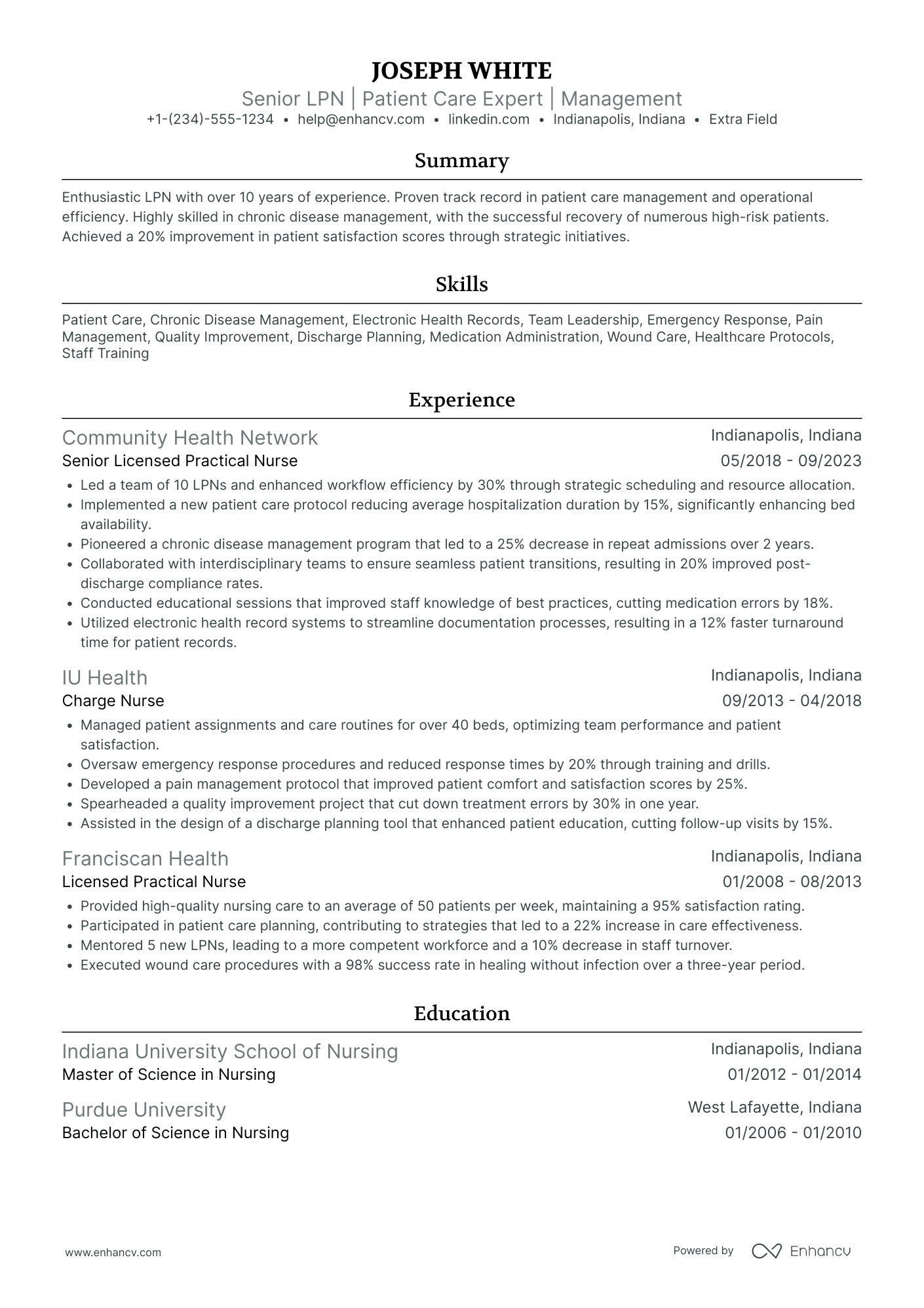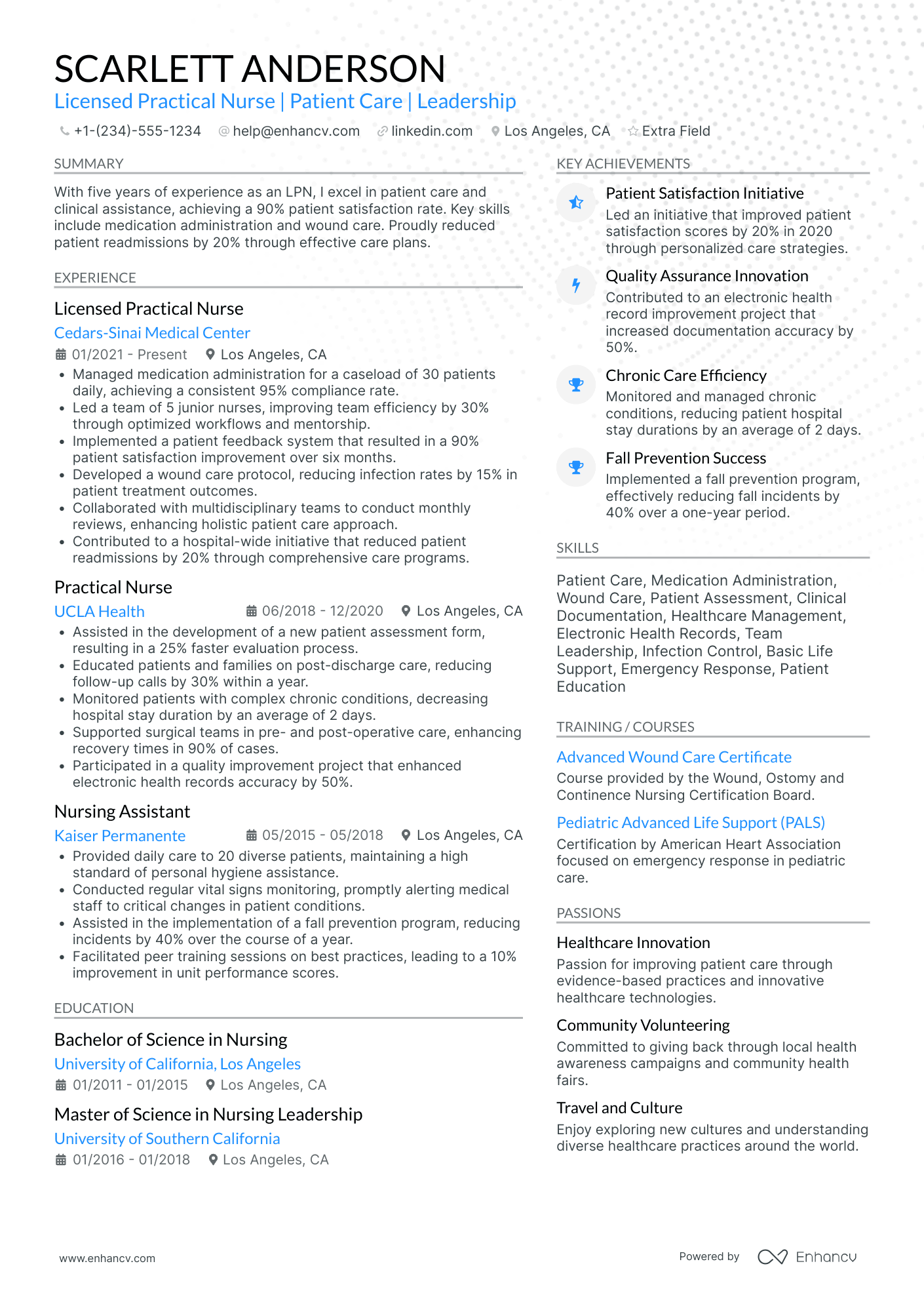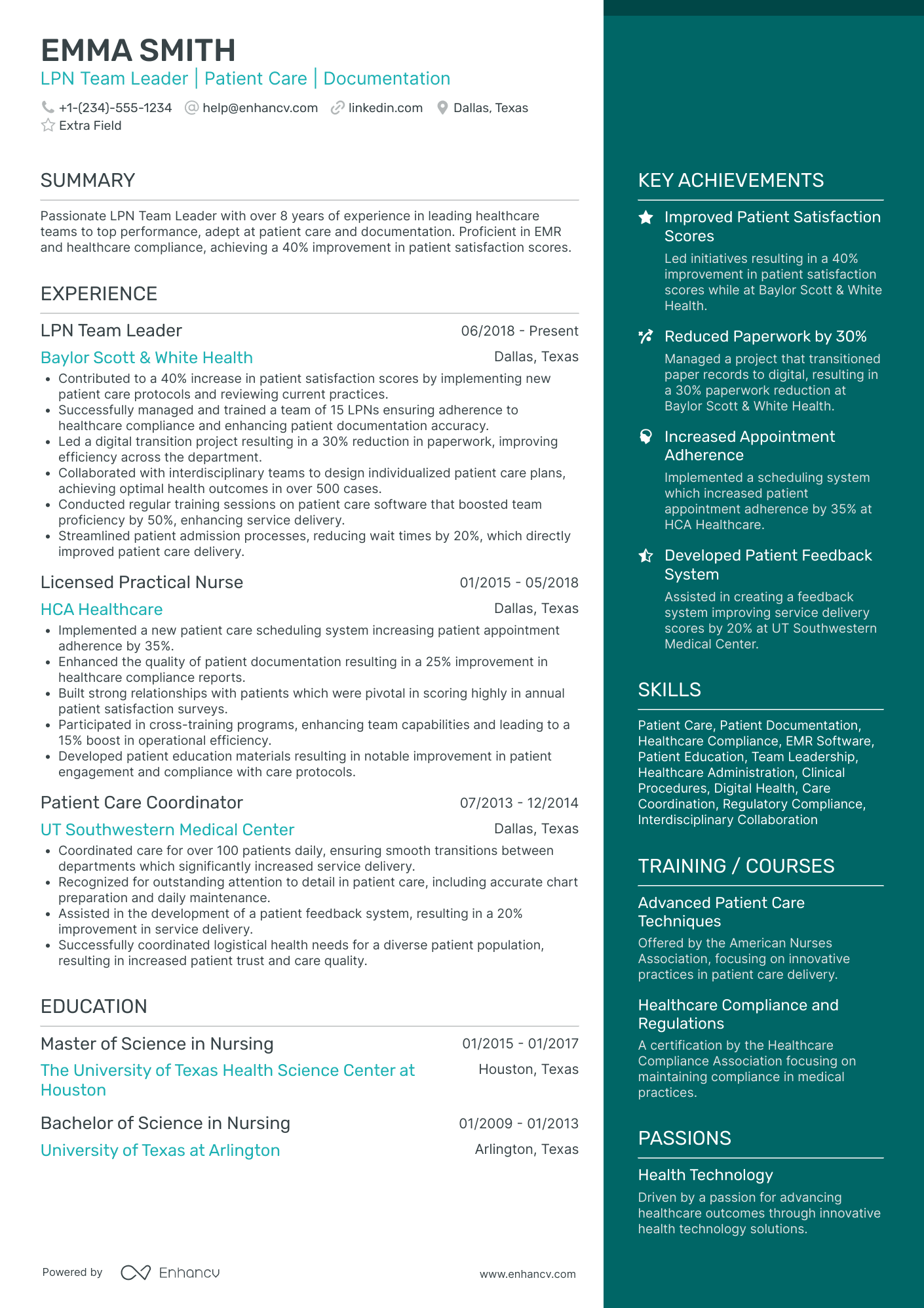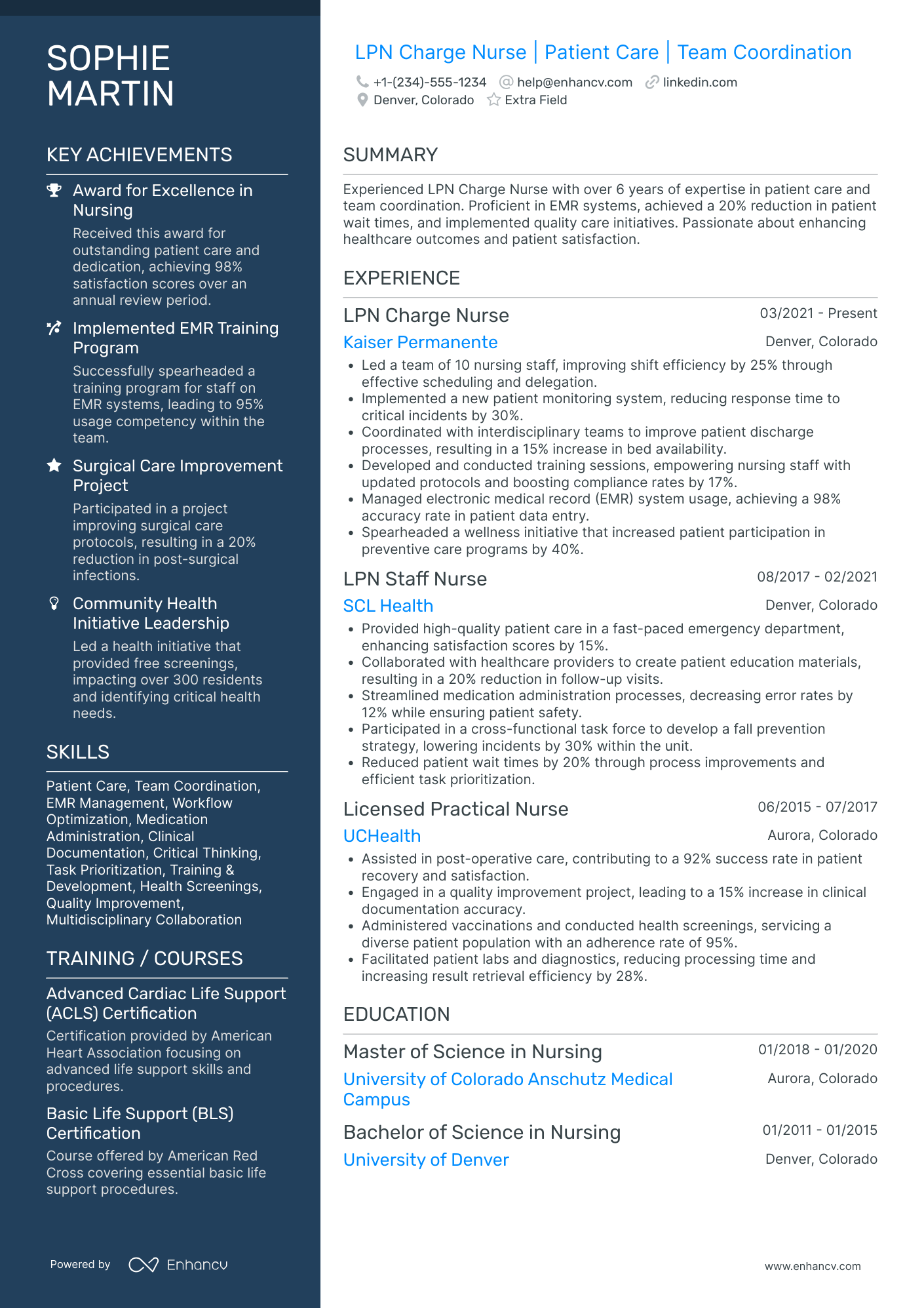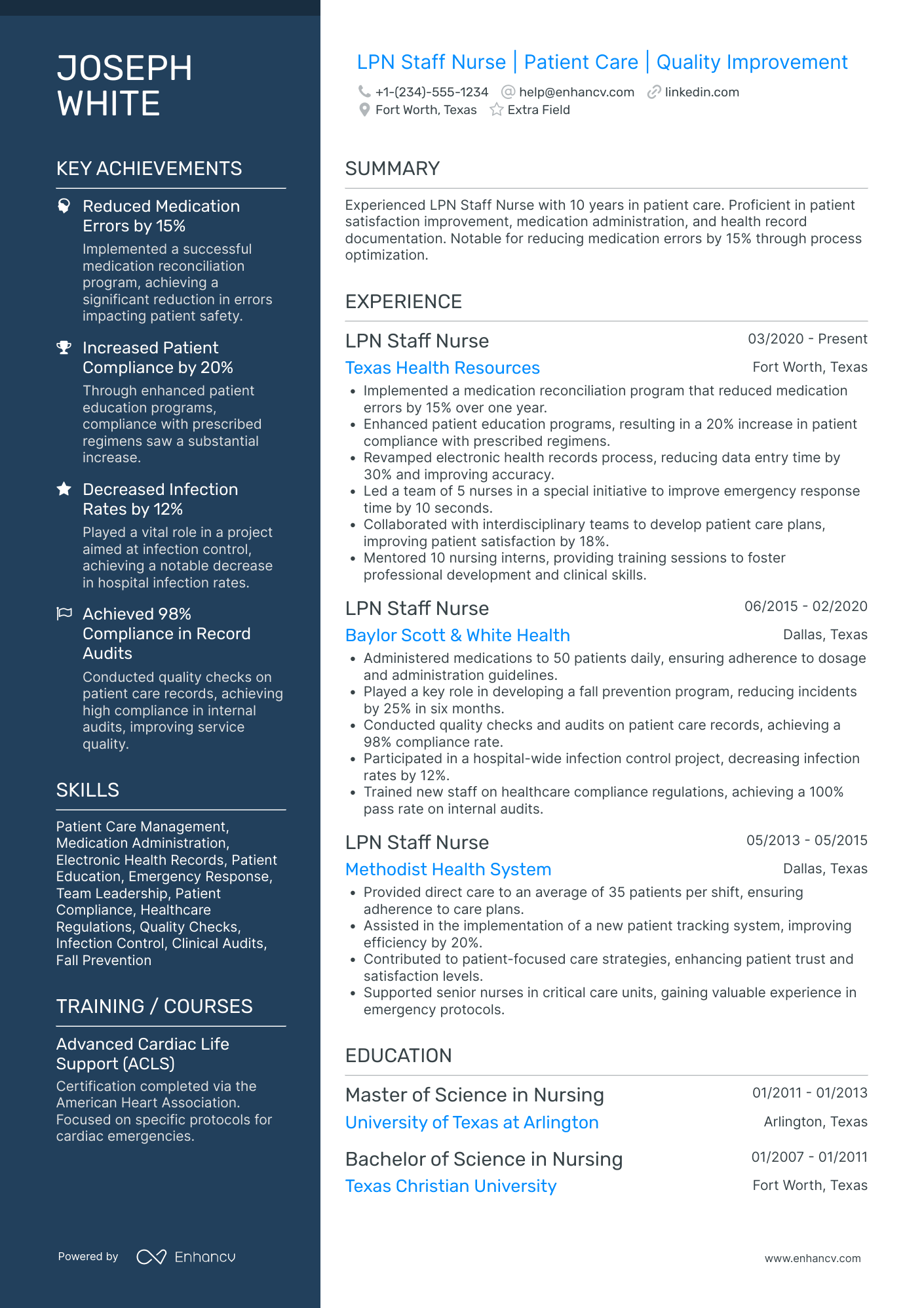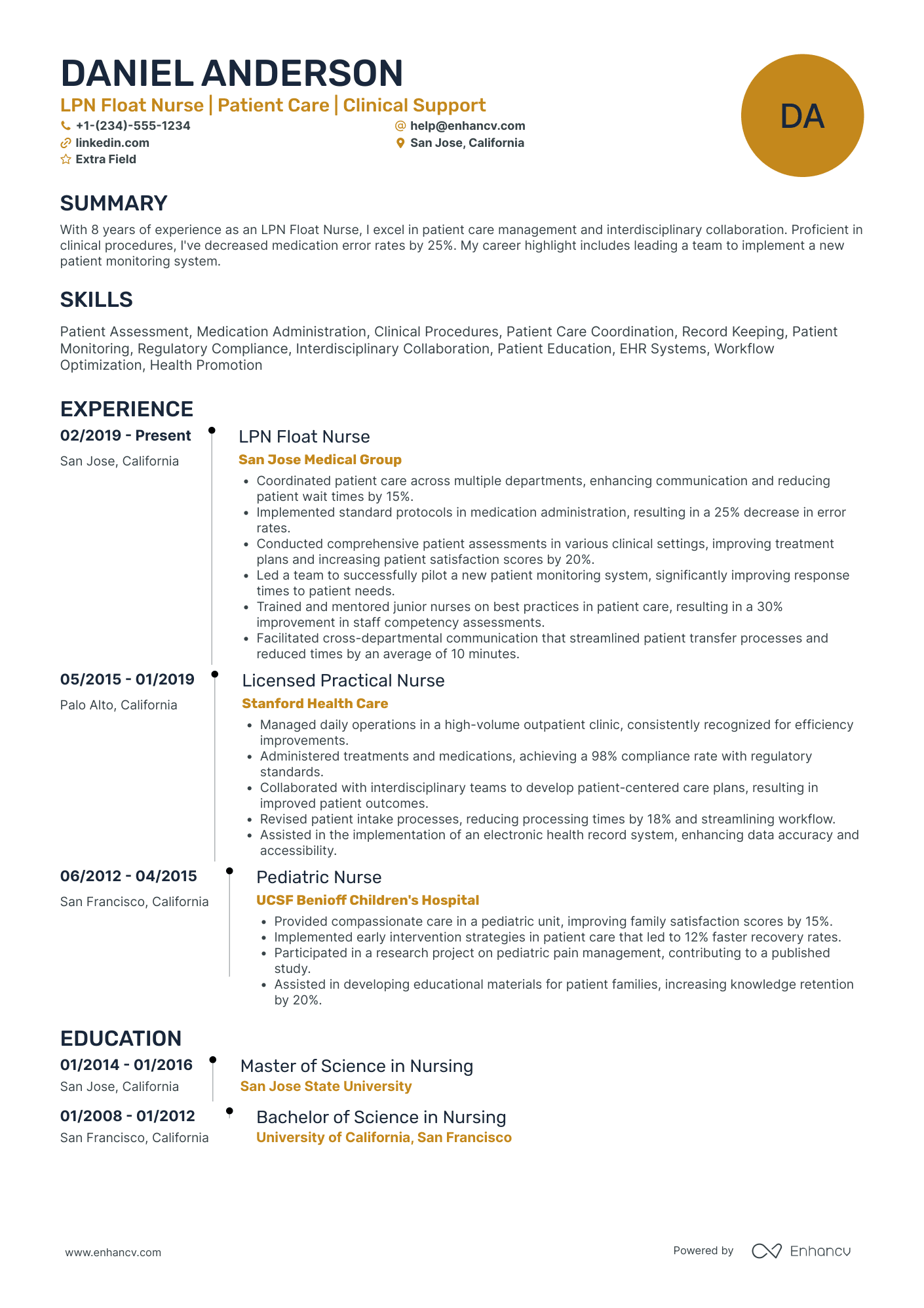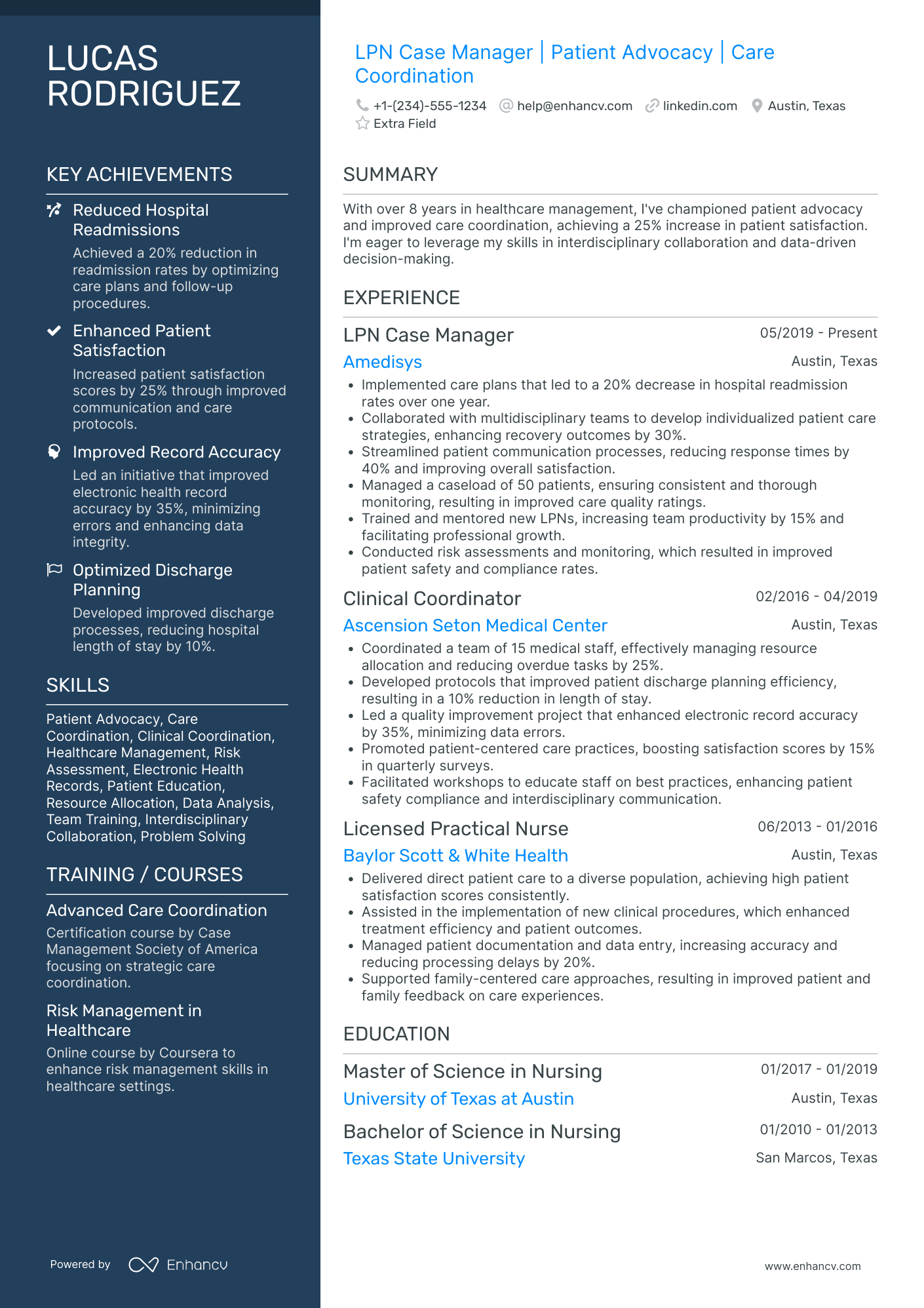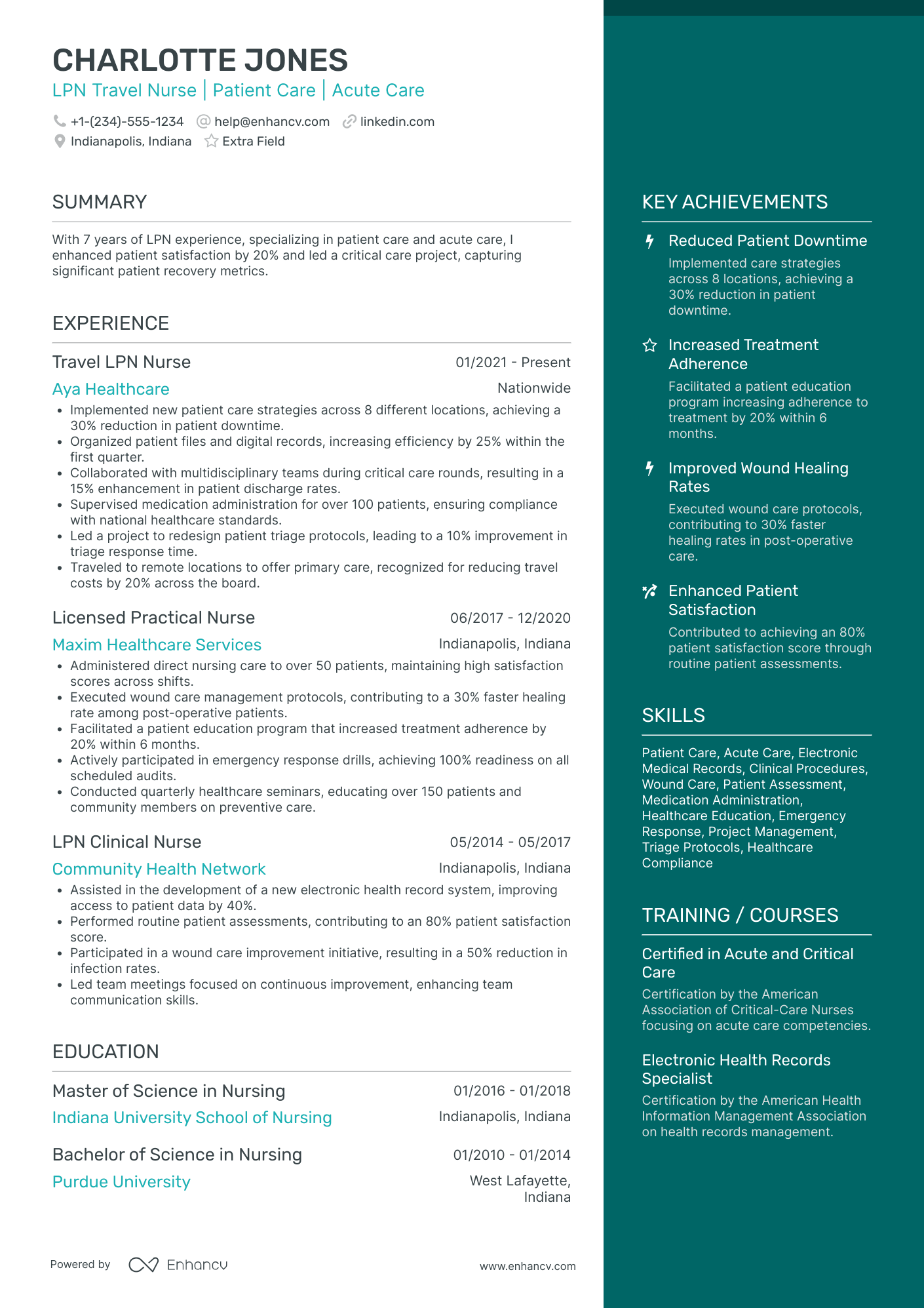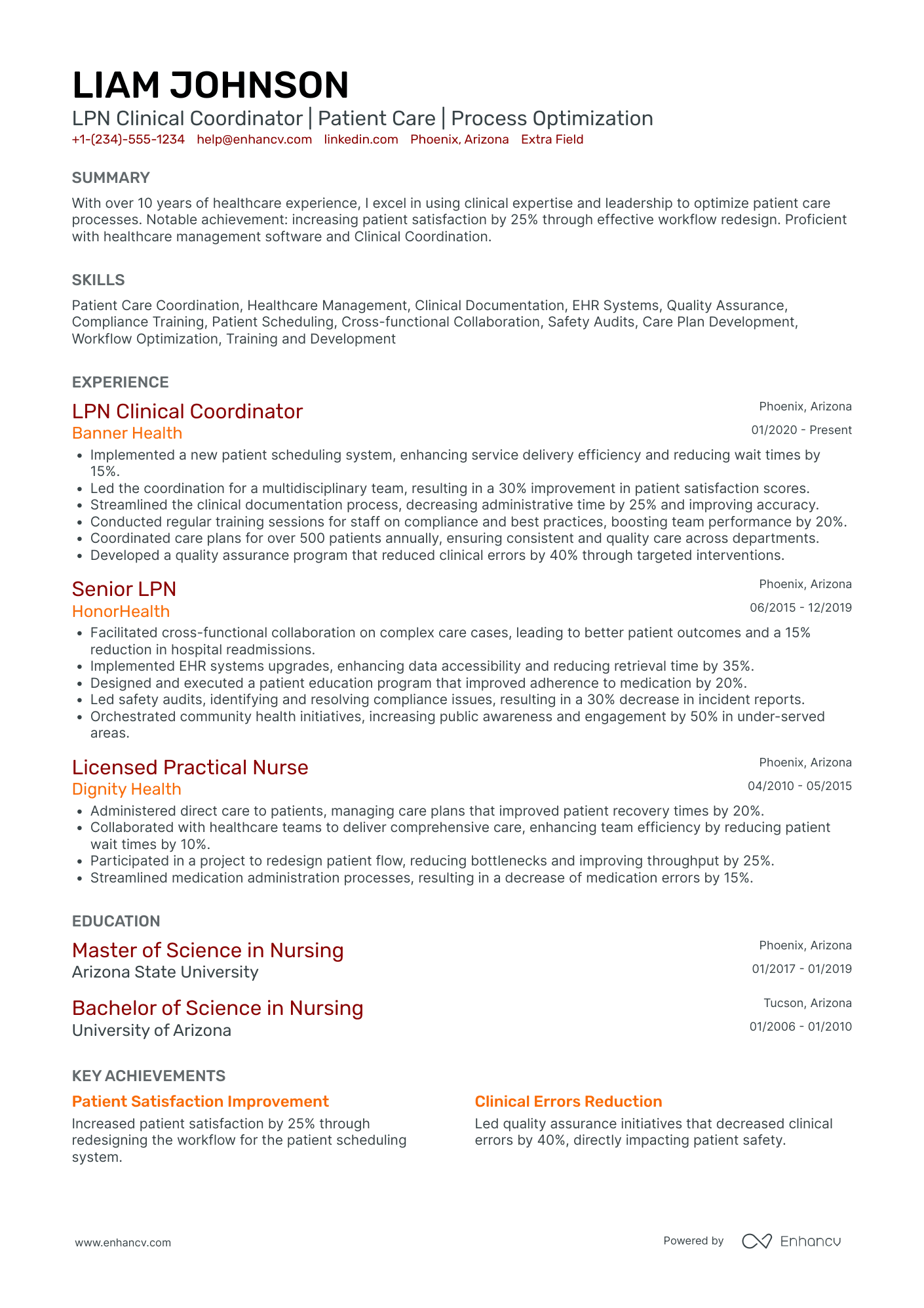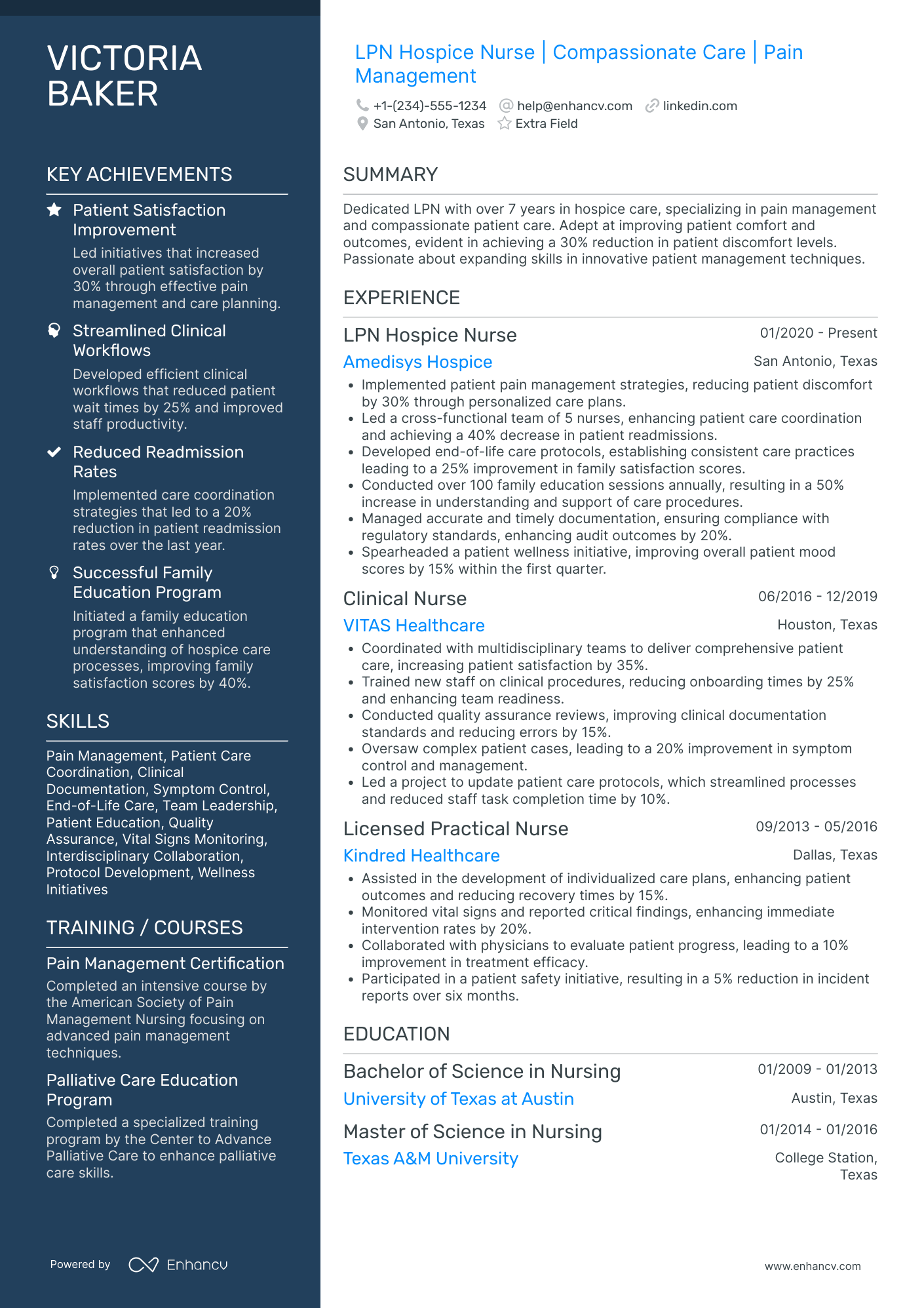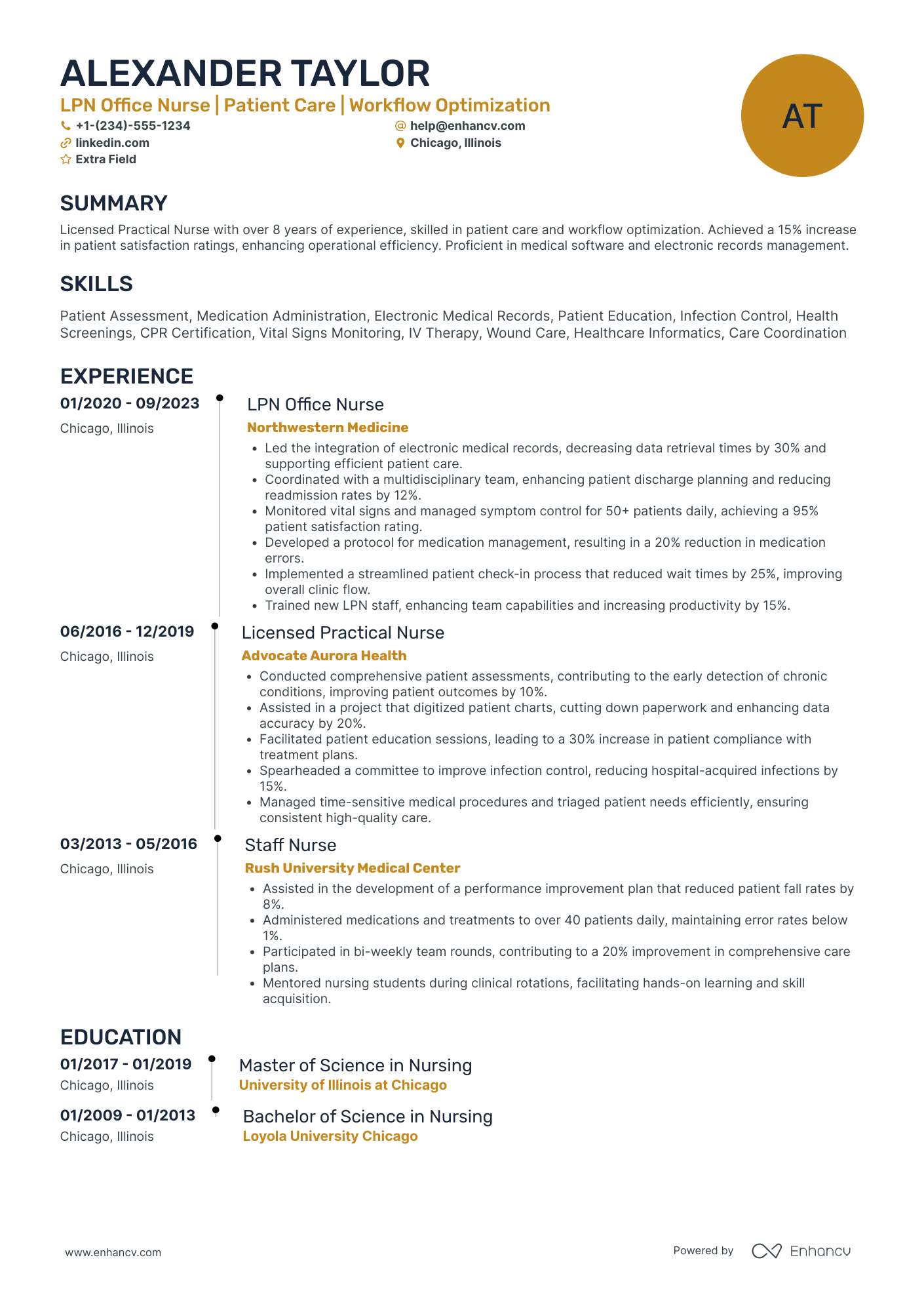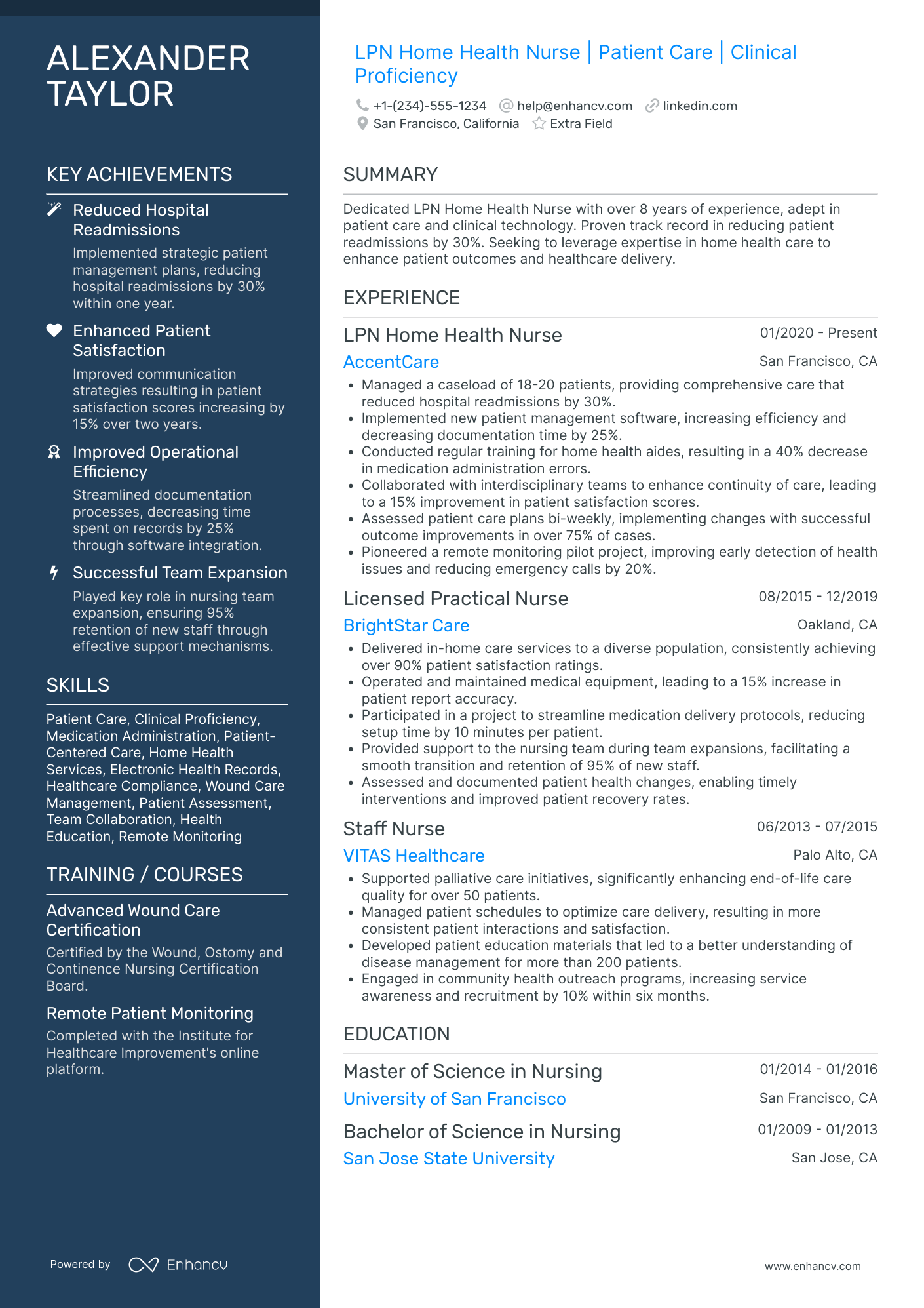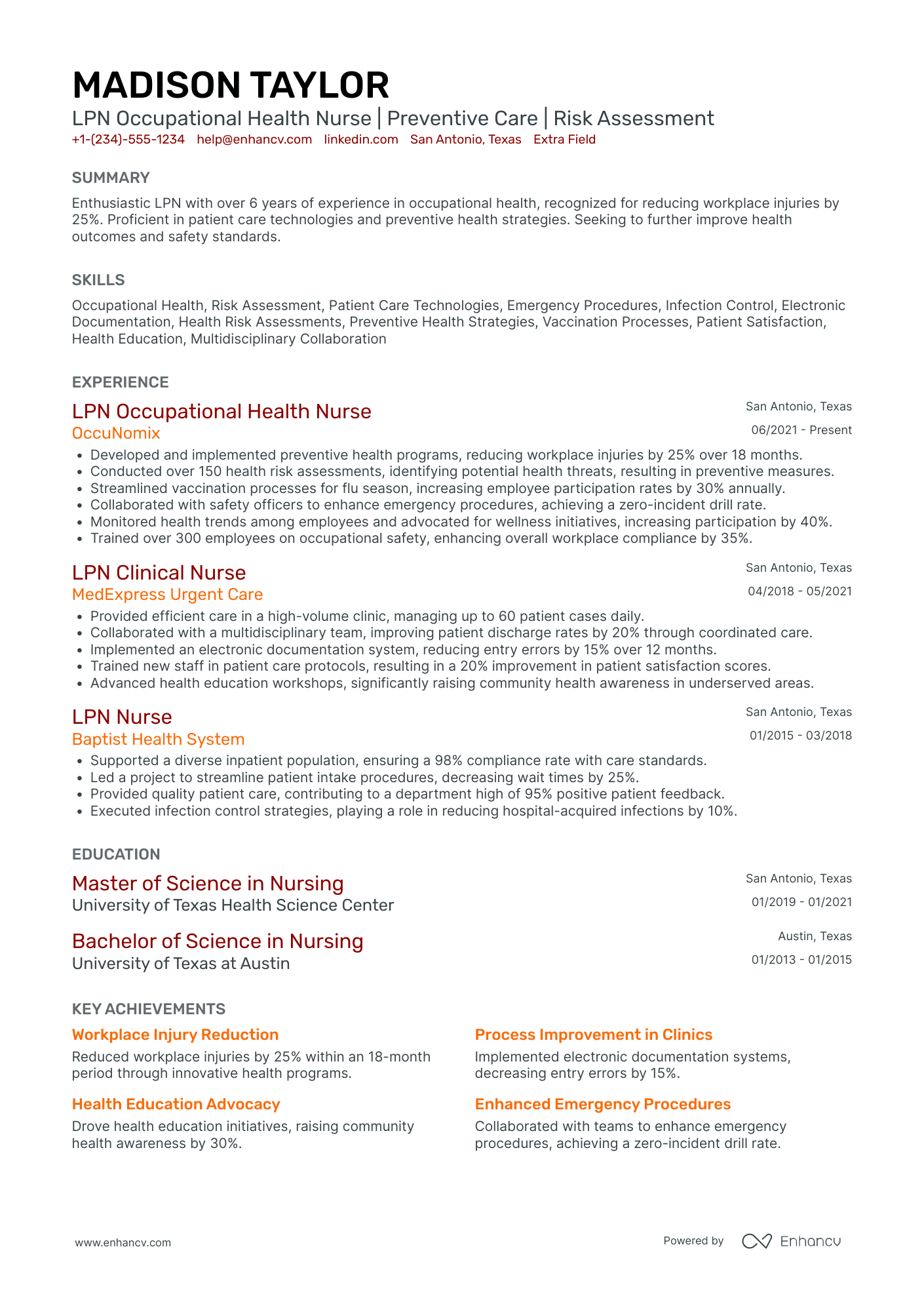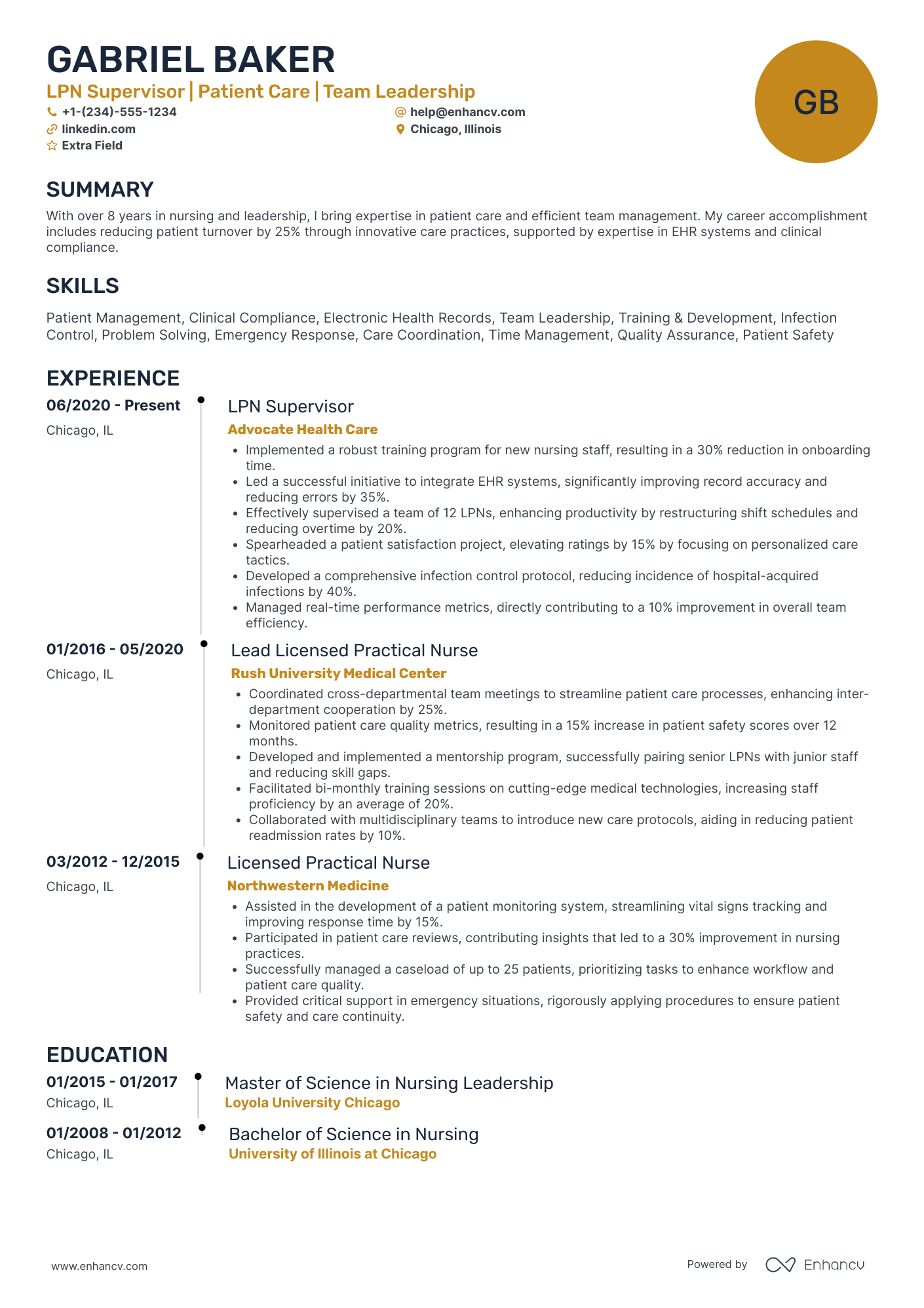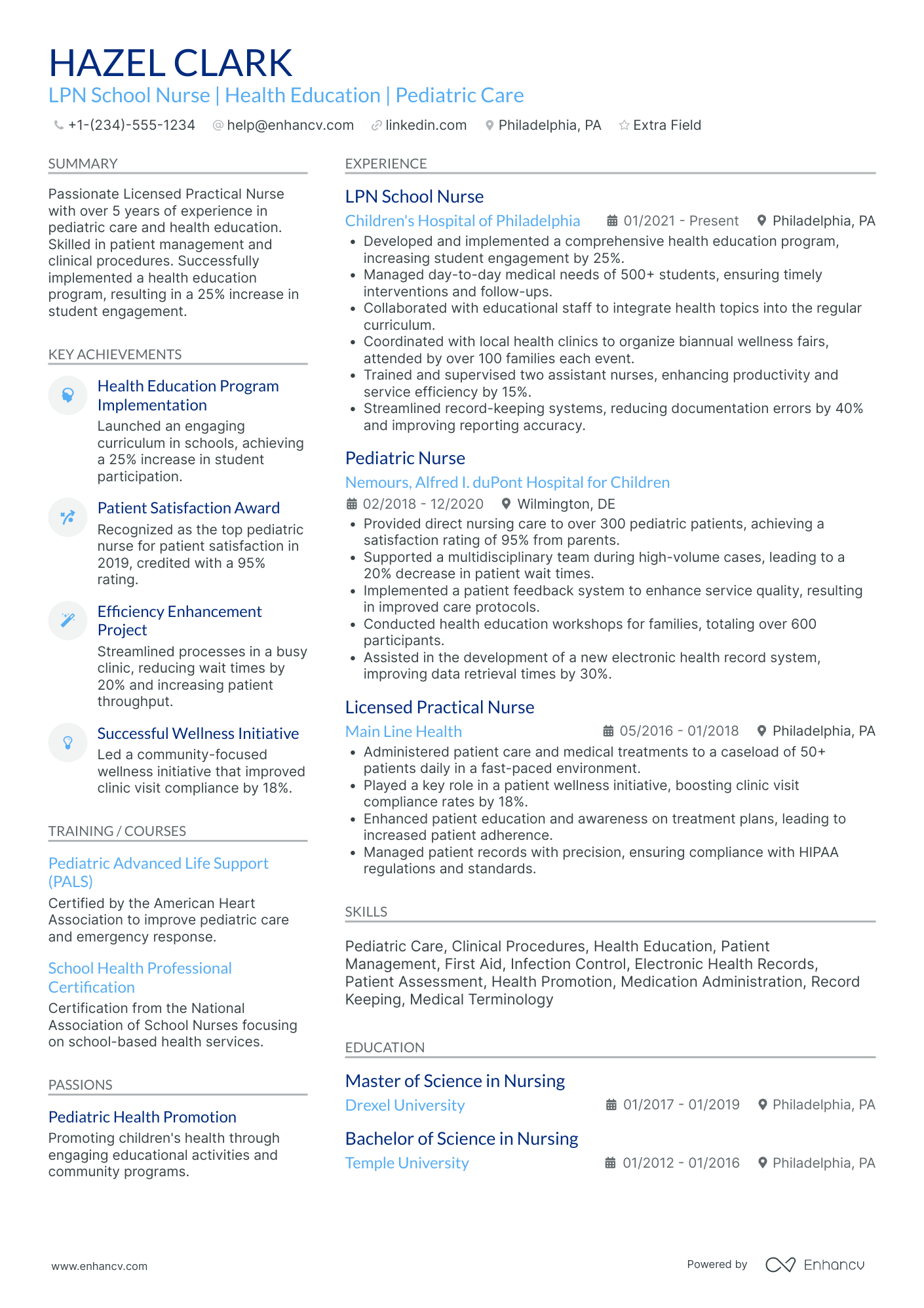Becoming a Licensed Practical Nurse (LPN) is more than a career choice—it's a commitment to vital healthcare services. While some see the LPN role as a step towards becoming a Registered Nurse, LPNs are essential, significantly impacting patient care at all healthcare levels.
The journey of an LPN involves rigorous demands, including long hours, high-stress situations, and the emotional challenges of dealing with illness and loss. It requires resilience and a profound commitment to patient welfare, highlighting the critical role of LPNs in the medical field.
This resume guide will cover the key elements of crafting a compelling LPN resume. It will cover how to effectively describe your invaluable skills and experiences to advance in your current role or emphasize your dedication and expertise, setting the stage for achieving your career goals in healthcare.
Key takeaways
- Use a classic layout including: a reverse-chronological format, a simple/traditional design, subtle colors and easy-to-read fonts.
- Make sure your experience section includes day-to-day tasks and responsibilities related to patient care.
- Craft a skills section with industry-specific hard skills and intersperse your experience section and resume profile with your people skills.
- Dedicate enough time to your education section, so you can show your qualifications.
- Place some additional sections to give a more well-rounded outlook of your personality.
Next, let’s see a practical resume sample to see these tips in action.
LPN resume sample
Your busy LPN schedule needs quick solutions. Why not use the LPN resume example below as a template for your own? Or, you could use the Enhancv builder and be done within minutes!
Emily Johnson
Licensed Practical Nurse
emily.johnson@email.com @LinkedIn Springfield, IL
Summary
Dedicated Licensed Practical Nurse with over 5 years of experience in fast-paced healthcare settings, skilled in patient care and clinical documentation. Proficient in monitoring vital signs, assisting with hygiene needs, and maintaining detailed medical records. Committed to providing compassionate care and working effectively within multidisciplinary teams to enhance patient outcomes.
Experience
Licensed Practical Nurse
St. John's Hospital, Springfield, IL
June 2019 – Present
- Monitor patient vital signs and report abnormalities to the supervising RN or physician.
- Administer medications and injections as prescribed and monitor responses.
- Assist patients with daily hygiene, including bathing and oral care.
- Educate patients and families on treatment plans and healthcare needs.
Licensed Practical Nurse
Springfield Health Clinic, Springfield, IL
May 2015 – May 2019
- Conducted initial patient assessments and recorded medical histories.
- Assisted in minor medical procedures and ensured compliance with sanitation protocols.
- Facilitated communication between patients and doctors, improving patient understanding of treatment strategies.
- Supported patient mobility and transportation within the facility.
Education
Associate Degree in Nursing
Lincoln Land Community College, Springfield, IL
Graduated: 2015
Certifications
- Licensed Practical Nurse (LPN), State of Illinois
- Basic Life Support (BLS)
- Advanced Cardiovascular Life Support (ACLS)
Skills
- Vital Signs Monitoring
- Medication Administration
- Medical Record Keeping
- Patient Education
- Infection Control
Languages
- English (Native)
- Spanish (Conversational)
Having seen a resume sample, let's explore different resume formats to understand which one suits your needs best.
How to format an LPN resume
As a LPN, you don’t need a visually stunning resume. Opt for a simple or a traditional resume template that will convey your seriousness and professionalism.
Resume format
Pair your classic layout with a classic approach when listing your experience. You can’t go wrong with the reverse-chronological format: it’s widely recognised and convenient as it lists your experiences starting with the most recent.
Top sections on a resume
Having chosen the right resume format, keep in mind the resume sections you should include:
- Personal information
- Professional summary
- Work experience
- Education and licensing
- Special skills or qualifications
More details on each section follow.
Resume designs
- Aim for a 1-page resume. Your profession has taught you how important it is to be concise and choose the right words, so apply this to your application.
- Ensure readability with margins between 0.5” and 1” on all sides.
- Save space and make your resume easily scannable with a two-column layout.
- Focus on important aspects by adding subtle colors and matching them with classic fonts, such as Arial, Garamond, or Times New Roman.
Contact information
Your resume header is your calling card. So, it should include all the essentials: your name, job title, and contact information. Generally, a photo isn’t needed, unless the specific place you’re applying for requires it.
PRO TIP
Contrary to popular belief, our tests showed that fonts, colors, columns, and resume length don’t affect Applicant Tracking Systems parsing. Focus on matching job description language and formatting details like dates and bullet symbols as those may affect your application.
File formatting
Keep all your resume elements intact with a PDF format, unless your desired job posting says otherwise. Use a simple naming convention, such as: FirstName_LastName_JobTitle.
Got a resume already? Run it through our free AI resume checker to ensure it’s up to standard!
Is your resume good enough?
Drop your resume here or choose a file. PDF & DOCX only. Max 2MB file size.
With a polished format in mind, we'll focus next on detailing your work experience effectively on your resume.
How to write your LPN resume experience
Your experience section holds the most significance—after all, it’s where potential employers will find out most about who you are as an employee and as a person. Think what are the strongest points you can include in each experience entry, and structure them with bullets and action verbs.
Instead of listing generic responsibilities, incorporate real examples in this section to keep HRs engaged.
Make sure you include information on:
- The medical institutions you worked for and the period you spent there.
- Your day-to-day tasks and responsibilities related to patient care.
- Any medical software you work with.
Let’s take a look at a real LPN job description.
LPN/LVN
Job Description
Licensed Practical Nurses (LPNs) work alongside an interdisciplinary team to provide whole-person quality care to patients in need. Nurses are empowered by our shared governance model that includes nursing staff in the process of creating practice standards and expectations.
Working in Home Health provides the unique opportunity to care for your patients where they are most comfortable. Join our team to create rewarding relationships with a diverse patient population while exercising independence and flexibility with your career.
Required Qualifications
- Graduate of an accredited LPN/LVN school of nursing
- National Provider BLS - American Heart Association upon hire
- Oregon Licensed Practical Nurse upon hire
- Washington Licensed Practical Nurse upon hire - if practicing within this state
- Upon request: Driving may be necessary as part of this role. Caregivers are required to comply with all state laws and requirements for driving. Caregivers will be expected to provide proof of driver license and auto insurance upon request. See policy for additional information.
- Driving record consistent with GOP Safe Driving Policy 330 Incident Point Matrix at time of hire.
- In compliance with the Providence St. Joseph Health - OR, criminal background check upon hire.
- 1 year experience in nursing; long term care, acute care, ambulatory care or home health and hospice care
Preferred Qualifications
- Experience in home health, hospice or public health
Create a targeted experience section
Tailoring your resume to the specific job posting is the strategy that’ll secure you a job interview. Recruiters only have limited time to scan your resume, so they’ll appreciate seeing keywords from the job ad in your experience section.
Here’s a sample entry targeting the job ad above:
- •Managed care for over 100+ patients annually in their homes, adapting plans to meet diverse health needs while ensuring comfort and privacy.
- •Collaborated actively in a team of 15+ healthcare professionals to develop and implement nursing practice standards that improved patient outcomes by 20%.
- •Maintained 100% compliance with both Oregon and national licensure requirements, including ongoing certification with the American Heart Association for BLS.
- •Utilized advanced technical skills to operate and maintain medical equipment, ensuring accurate monitoring and support for critical care patients.
- •Provided compassionate end-of-life care, effectively communicating with patients and families to ensure comfort and dignity during sensitive stages.
- •Led quarterly training workshops for new nurses, focusing on patient care techniques, documentation procedures, and compliance with healthcare regulations.
Here’s why the example’s a good one:
- Includes specific numbers, such as managing care for over 100+ patients annually and improving patient outcomes by 20%, providing concrete evidence of the candidate’s effectiveness and direct contribution to healthcare.
- Detailing responsibilities like managing a large patient base and collaborating with over 15 healthcare professionals highlights the candidate’s capacity to handle significant duties, aligning well with the job’s requirements.
- Emphasizes maintenance of 100% compliance with licensure requirements underscores the candidate’s dedication to professional standards, crucial for the job’s strict certification norms.
To strengthen your resume, it’s crucial to quantify your work experience—let's learn how to do that.
How to quantify your experience on a resume
When your main focus is caring about patients, quantifying your achievements might seem like the last thing on your mind. However, it’s a practical way to show how you’ve made a real difference.
On an LPN resume, aim to translate your hard work into clear, impactful results, proving that you do more than just the job—you excel at it, enhancing both patient outcomes and the efficiency of your healthcare team. Here’s how you can approach it:
- Include the number of patients you typically cared for on a daily basis, as this illustrates your ability to handle workload and prioritize care.
- Document any reduction in patient readmission rates or improvement in patient health outcomes under your care, showing your effectiveness as an LPN.
- List any specific procedures you are competent in, along with the frequency with which you performed them, demonstrating both your specialized skills and experience.
- Showcase any continuous education or training courses where you achieved exemplary scores, highlighting your commitment to enhancing your skills.
- Mention any instances where your proactive actions led to streamlining or efficiency improvement in your former employment, providing evidence of your contribution to a more effective work environment.
If you’re new to the workforce, don't worry. Here’s how to handle a resume with little to no experience.
How do i write a LPN resume with no experience
Let’s say you’re a fresh graduate and you now want to pursue a career in nursing. It’s natural you’re a bit overwhelmed about where to begin. Even if you have no practical experience, you can still fill your resume with important things you’ve done, such as:
- Volunteer work
- Internships
- Relevant practical experience
When you’re an entry-level LPN, focus on any valuable experience you’ve gained so far, and pair it with a strong set of transferable skills and academic achievements you’re proud of.
Use a skills-based resume format and include an engaging resume objective on top. Keep it short (1 - 3 sentences) and make sure you clearly state what you think you can contribute, and why you want to work in that particular place. Like so:
The resume objective works well because it clearly shows the LPN's commitment and skills, emphasizing their role in improving patient care and teamwork. This makes the candidate stand out as a valuable team player in any healthcare setting, which is key in a competitive job market.
From here, we’ll transition to discussing the essential hard and soft skills to include on your resume.
LPN resume skills
Every recruiter is interested in the specific skill set you’ve got to offer. The hard skills you need can vary depending on the nursing position you’re applying for. These refer to the specific medical abilities you might need to be efficient at your job. For example:
Best hard skills for your LPN resume
- Patient care
- Medication administration
- Vital signs monitoring
- Wound care
- CPR certification
- First Aid skills
- Infection control
- Intravenous (IV) therapy
- Diabetes management
- Cardiac life support
- Knowledge of medical software (Electronic Health Records)
- Pediatric nursing
- Geriatric care
- Obstetric and Gynecological care
- Surgical prep
- Medical terminology
- Pharmacology
- Rehabilitation therapy
- Emergency response
- Life support technologies
Soft skills are an integral part of your resume as an LPN. Your job is about helping others, so you want to show the recruiter your people skills are top-notch. A good idea is to weave these into your experience section or summary, with concrete examples.
Best soft skills for your LPN resume
- Communication
- Empathy
- Patience
- Teamwork
- Problem-solving
- Detail orientation
- Time management
- Stress management
- Responsiveness
- Active listening
- Flexibility
- Critical thinking
- Decision-making
- Resilience
- Professionalism
- Emotional intelligence
- Organization
- Initiative-taking
- Cultural competence
Now, let’s enhance your resume even further by incorporating your education and certifications.
How to list your education and certifications on your resume
Your education section is paramount on your LPN resume. It teaches you the skills and knowledge needed to go into the field, sets the stage for career advancement, and demonstrates qualifications and proficiency.
When organizing this entry:
- List your educational institution to highlight credibility and professionalism.
- Specify the year you graduated to provide context and the recentness of your education. Skip the month.
- Mention relevant courses such as pediatric nursing or pharmacology.
- Point out any academic achievements, such as Dean's List, graduated Cum Laude, or received a scholarship.
Here’s an example targeting the job posting above:
- •Completed specialized courses in home health care and patient management.
- •Participated in extensive clinical rotations in long term care, acute care, and ambulatory settings.
This education section entry underlines specialized coursework and relevant clinical experience. Other assets are the qualifications specific to home health care, aligning educational achievements with job requirements.
You can also dedicate some resume space to list your certifications. It’s a quick and effective way to show your potential employers you’ve taken the time and effort to get qualified beyond the basic requirements.
Best certifications for your LPN resume
PRO TIP
If you're in the process of obtaining your certificate or degree, list the expected date you're supposed to graduate or be certified.
After covering your educational background, the next step is to craft a compelling resume summary.
How to write your LPN resume summary
When they initially scan your resume, recruiters will definitely look at your career statement. If you’ve got substantial experience already, consider adding a resume summary to your document. It should contain:
- 3 – 5 sentences on your best qualities and qualifications.
- Active voice and resume buzzwords, such as patient care, team collaboration, and medication administration.
- Measurable experience that gives insight into your accomplishments.
- Additional training that adds value.
- And finally, highlight what you can do for the company.
We’ve tailored this summary to the job posting we discussed earlier:
This resume summary emphasizes the applicant’s commitment to patient-centered care and their ability to adapt to the specific demands of home health services, outlining their preparedness and suitability for the role.
With your resume taking shape, let’s consider adding additional sections to further underscore your skills and achievements.
Optimize your resume summary and objective for ATS
Drop your resume here or choose a file.
PDF & DOCX only. Max 2MB file size.
Additional sections for a LPN resume
If you have space available, and you want to provide more depth to your professional profile, additional sections can be the way to go. You can add one of the following:
- Including volunteer work, especially in healthcare settings, shows commitment to the community and can reveal a well-rounded skill set.
- Listing memberships in professional organizations can indicate an ongoing engagement with the latest industry trends and standards.
- Displaying recognition received in nursing or related fields can signal excellence and reliability in your profession.
- Continuing education, including courses and seminars, taken beyond initial certification indicates a dedication to career development and staying updated with medical advancements.
PRO TIP
You can even add a customized My Day section using the Enhancv resume builder. It provides potential employers with an insightful breakdown of an LPN's daily responsibilities and skills, bringing out their ability to manage multiple tasks efficiently and effectively.
In conclusion
A licenced practice nurse resume has to prove your dedication to patient care and your eagerness to bring your skills to a new facility, showing your commitment and professionalism.
LPN resume examples
By Experience
By Role

